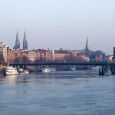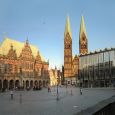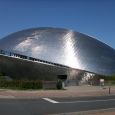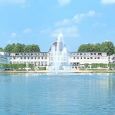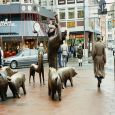Bremen
Advertisement
By Air
Bremen airport (IATA: BRE) (ICAO: EDDW) is in the south-west of the town and offers flights to most bigger German cities and some European destinations. It's easily accessible by public transport (tram line 6, about 16 minutes from the city center) and by car.Major carriers are OLT, Ryanair and Lufthansa.
By Train
The Bremen S-Bahn covers the Bremen/Oldenburg Metropolitan Region, from Bremerhaven in the north to Twistringen in the south and from Oldenburg in the west.It has been in operation since 2010.This network unified existing regional transport in Bremen as well as surrounding cities, including Bremerhaven, Delmenhorst, Twistringen, Nordenham, Oldenburg, and Verden an der Aller.The network lies completely within the area of the Bremen-Lower Saxony Transport Association, whose tariff structure applies.
By Bus
Bremer Strabenbahn AG (translates from German as Bremen Tramways Corporation), often abbreviated BSAG, is the public transport provider for Bremen, offering tramway and bus services.
Advertisement
Ubersee Museum Bremen
is a Natural History and Ethnographic museum in Bremen, Germany. In an integrated exhibition, Nature, Culture and Trading, it presents aspects of overseas regions with permanent exhibitions relating to Asia, South Pacific/Oceania, Americas and Africa.In 1875, the collections of the Bremen Natural History Society became become the property of the city of Bremen under the name "Municipal Collections of Natural History and Ethnography" , the library of the society having been given to the city in 1872.
Kunsthalle Bremen
is an art museum in the Hanseatic City Bremen, Germany.The Kunsthalle was built in 1849 and enlarged in 1902 by architect Eduard Gildemeister.The museum houses an important collection of paintings from the 19th and 20th century including works of artists from the nearby art colony of Worpswede.
Bremen Cathedral
dedicated to St. Peter, is a church situated in the market square in the center of Bremen, in northern Germany. The cathedral belongs to the Bremian Evangelical Church, a member of the Protestant umbrella organisation named Evangelical Church in Germany. It is the proto-cathedral of the former Prince-Archbishopric of Bremen.The first church structure that can be verified on the site of St Peter's Cathedral in Bremen was a timber church on on a high point overseeing the Weser River built by Saint Willehad, an early missionary to the Frisians. The church was built about 789 in conjunction with the creation of the Diocese of Bremen with Willehad as the first bishop. Willehad died the same year.Just three years later Saxons attacked and burned Bremen and its tiny timber cathedral. No trace of it remains. The see remained vacant for thirteen years until it was reestablished under Bishop Willerich in 805. St Peter's was built as the cathedral church of local sandstone in several stages by Bishop Willerich.
Bottcherstrabe Street
is a street in the historic centre of Bremen, Germany. Only about 100 m (330 ft) long, it is famous for its unusual architecture and ranks among the city's main cultural landmarks and visitor attractions. Most of its buildings were erected between 1922 and 1931, primarily as a result of the initiative of Ludwig Roselius, a Bremen-based coffee-trader, who charged Bernhard Hoetger with the artistic supervision over the project. The street and its buildings are a rare example of an architectural ensemble belonging to a variant of the expressionist style. Several of the houses can be classed as Brick Expressionism.Today, Bottcherstrabe is one of the major tourist attractions of Bremen. It contains several art museums (Kunstsammlungen Bottcherstrabe), Arts and crafts workshops, bars, restaurants and shops, Bremen casino and a hotel. Nearly all buildings and plots are owned by the foundation.
Rhododendron Park Bremen
is a major collection of rhododendrons and azaleas, as well as a substantial botanical garden (3.2 hectares), located at Deliusweg 40, Bremen, Bremen (state), Germany.It is open daily; park admission is free but a fee is charged for Botanika.The botanical garden dates to 1905 when it was created by businessman Ernst Franz Schutte at a different site (1905 Osterdeich, 3 hectares).This original garden was organized geographically, with plants from the Orient, Mexico, and the Caucasus, as well as collections of crop plants, medicinal herbs, native plants, and poisonous plants.It remained privately held until 1935 when it became city property, and was transferred to its current location within the Rhododendron Park over the next few years.Today's garden was completed in 1949-1950.The park itself began in 1933 at the initiative of the German Rhododendron Society on former farmland and forest, opening to the public in 1937. Its Botanika facility, described as Germany's largest nature center, opened in 2003. In 2007 ownership of the park was transferred to a nonprofit foundation.
Universum Science Center
is a science museum in Bremen, Germany.Visitors are encouraged to interact with most of the approximately 250 exhibits.It receives on average 450,000 visitors annually.The Universum Bremen opened in September 2000 near to the University of Bremen, Germany.Covering over 4,000 m2 the exhibition contains exhibits related to one of the three topics: mankind, earth and the cosmos.The science center building, with its 40,000 stainless steel scales, resembles a mixture between a whale and mussel.It was designed by the Bremen architect Thomas Klumpp.In 2007 the Universum opened a large outdoor area, the EntdeckerPark, and a new building, the SchauBox. In contrast to the curved metallic older building, the SchauBox, developed by Haslob Kruse and Partner, is cubic with a rust-red exterior. It is used for additional exhibitions, which change annually.
Bremen Roland
is a statue of Roland, erected in 1404.It stands in the market square (Rathausplatz) of Bremen, Germany, facing the cathedral, and shows Roland, paladin of the first Holy Roman Emperor Charlemagne and hero of the Battle of Roncevaux Pass. Roland is shown as protector of the city: his legendary sword (known in chivalric legend as Durendal) is unsheathed, and his shield is emblazoned with the two-headed Imperial eagle.The standing figure is 5.47 m tall, and stands on a 60 cm rostrum.A supporting column, crowned by a baldachin, brings the combined height to 10.21 m.The statue was carved in limestone from Elm, and was commissioned by the city fathers to replace a wooden one burnt in 1366 by Prince-Archbishop Albert II. It confronts the church as a representation of city rights opposed to the territorial claims of the prince-archbishop.
Information not available
Information not available
Advertisement

